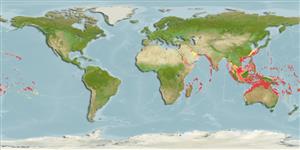Common names from other countries
分類 / Names
共通名の | 類義語 | Catalog of Fishes(部類, 種) | ITIS | CoL | WoRMS | Cloffa
Environment: milieu / climate zone / depth range / distribution range
生態学
海; 汽水性の 関連する礁; 深さの範囲 0 - 150 m (Ref. 30573), usually 10 - 137 m (Ref. 27115). Tropical; 25°C - 28°C (Ref. 27115); 31°N - 32°S, 30°E - 122°W (Ref. 57251)
Indo-Pacific: Red Sea and East Africa (Ref. 9710), including the Mascarene Islands (Ref. 37792) to the Hawaiian, Marquesas and Ducie islands, north to southern Japan, south to Lord Howe Island.
Length at first maturity / サイズ / 重さ / 年齢
Maturity: Lm 45.0 range ? - ? cm
Max length : 75.0 cm FL オス/雌雄の選別がない; (Ref. 1602); common length : 50.0 cm TL オス/雌雄の選別がない; (Ref. 30573)
背面の脊椎 (合計) : 6; 背鰭 (合計) : 26 - 29; 肛門の骨: 2; 臀鰭: 27 - 30. This species is distinguished by the following characters: body moderately deep and compressed, its depth 2.6 to 3.2 times in standard length (SL); dorsal profile of body uniformly convex, without any bony horn-like projection or protuberance anteriorly on head; mouth small; incisiform teeth very small, somewhat pointed, finely serrate on edges, as many as 80 in upper jaw and 100 in lower jaw of large adults; continuous unnotched D VI (rarely V or VII),26-29; A II,27-30; pectoral-fin rays 17-18 (usually 17); pelvic fins I,3; caudal fin slightly emarginate in young, becoming truncate in adults; caudal peduncle slender, subcylindrical, with a pair of bony plates on each side that develop large sharp antrorse keels with age; body colour dark brownish grey, shading ventrally to yellowish (life colour may vary from dark brown to light blue-grey); edge of operculum and preopercle usually dark brown; dorsal and anal fins yellowish with faint diagonal brown bands and a blue margin; tongue black at lengths of 25 cm or more (Ref. 9808).
Inhabits clear lagoon and seaward reef slopes (Ref. 9710, 48637). Benthopelagic (Ref. 58302). Usually seen in large schools (Ref. 90102). Mainly diurnal, it feeds on zooplankton such as crab larvae, arrow worms, pelagic tunicates, and occasionally filamentous red algae. The species is never poisonous (Ref. 4795). Minimum depth reported taken from Ref. 128797.
Life cycle and mating behavior
Maturities | 繁殖 | Spawnings | Egg(s) | Fecundities | 幼生
Spawn in pairs (Ref. 240).
Myers, R.F., 1991. Micronesian reef fishes. Second Ed. Coral Graphics, Barrigada, Guam. 298 p. (Ref. 1602)
CITES (Ref. 128078)
Not Evaluated
Human uses
水産業: 商業; ゲームフィッシュ: はい; 水族館・水槽: 商業
用具
特記事項
XMLをダウンロードして下さい
インターネットの情報源
Estimates based on models
Preferred temperature (Ref.
115969): 22.1 - 28.9, mean 27.5 (based on 2224 cells).
Phylogenetic diversity index (Ref.
82804): PD
50 = 0.5000 [Uniqueness, from 0.5 = low to 2.0 = high].
Bayesian length-weight: a=0.02188 (0.01362 - 0.03514), b=2.99 (2.85 - 3.13), in cm Total Length, based on LWR estimates for this species & Genus-body shape (Ref.
93245).
栄養段階 (Ref.
69278): 3.1 ±0.33 se; based on food items.
回復力 (Ref.
120179): 低い, 4.5年~14年の倍増期間の最小個体群 (tm=7; K=0.221; Tmax=44;).
Fishing Vulnerability (Ref.
59153): Moderate vulnerability (42 of 100).
